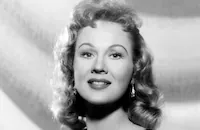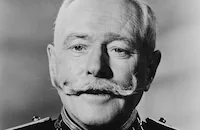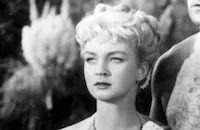Jet over the Atlantic
Brief Synopsis
Cast & Crew
Byron Haskin
Guy Madison
Virginia Mayo
George Raft
Ilona Massey
George Macready
Film Details
Technical Specs

Synopsis
FBI agent Stafford arrives in Spain to apprehend a convicted murderer, American Brett Matoon, who escaped from prison two years earlier. Unaware that the authorities know of his whereabouts, Brett proceeds with his plans to marry his girl friend, American showgirl Jean Gurney. Meanwhile, Lord Robert Leverett, deeply disturbed by the recent death of his young daughter Lori, illegally purchases a powerful chemical poison and after murdering the courier, proceeds with plans to take the chemical onboard an international flight to New York City. The next day, Stafford and Spanish police captain Rivas arrest Brett, who is allowed to telephone Jean to bid her farewell. Bewildered by Brett's abrupt call, Jean hastens to his apartment where she learns from the manager that Brett has been escorted to the airport. Jean follows and finds Brett and Stafford waiting for El Conquistador flight 400 to New York. Rivas informs Stafford of each passenger's identity as they board, including eccentric spinster Miss Hooten, famous opera singer Madame Galli-Cazetti, the Reverend Dean Halltree, Mrs. Lanyard and her young daughter Laura and Leverett and his wife Ursula. Upon seeing Brett board the plane with Stafford, Jean impulsively purchases a ticket. Shortly after takeoff, Miss Hooten notices that Brett is handcuffed to Stafford and spreads the information among the passengers. When Jean approaches Brett and reacts to the handcuffs, Stafford allows Brett to meet with her privately in the lounge, where he explains his situation: After the Korean war, aviation hero Brett struggles to find work. Stopping at a local bar one night, Brett is the only customer present when two men arrive and, angered over the owner's refusal to purchase liquor from their organization, shoot him and the busboy and, after knocking out Brett, place the gun in his hand. With no other witnesses to the crime, Brett is convicted for both murders and is convinced he will never be proved innocent. Meanwhile in the present, while Jean vows to stand by Brett, in the luggage compartment, the chemical mix in Leverett's trunk has become active. Unaware that Miss Hooten has eavesdropped on Brett and Jean's conversation, then repeated it in the main cabin, the couple is surprised when Stafford joins them and asks Brett if he still has the Spanish wedding license. Although Brett protests that Jean should not marry a felon, she is delighted by the suggestion and Halltree marries the couple with several passengers as witnesses. At the urging of Miss Hooten, Mme. Galli-Cazetti grudgingly agrees to give up her exclusive state room to the couple as a wedding gift. Later, Leverett notices young Laura sitting nearby and points out her likeness to their daughter to Ursula. In the cockpit, the pilot grows drowsy from the whiffs of gas coming from the luggage compartment below and turns the flight over to the co-pilot, retiring to his bunk to rest. As night falls and the passengers retire, the chemical in the trunk catches fire, releasing more powerful poisonous fumes. Upon getting a glass of water for Jean, Brett spots one of Stafford's associates asleep and steals his pistol. Jean has seen the theft and when she asks Brett his plans, he reveals his intention to hijack the plane to Canada where he can escape. Jean then reluctantly agrees to help. The growing fire in the luggage compartment sets off the automatic sprinklers and alerts the crew in the cockpit to the emergency. In the main cabin, the increasing heat has unnerved several passengers and when the co-pilot announces a fire, several panic. Leverett asks Mrs. Lanyard if he might comfort Laura as the flight attendants struggle to calm the passengers. Although the fire is extinguished, the chemical continues reacting, creating an oozing foam substance that radiates more noxious fumes. After detecting the gas in the cockpit, the co-pilot discovers the pilot and navigator have both died and radios a report ahead to the New York airport. Just after announcing to the passengers that they must make an emergency landing on water, the co-pilot collapses and dies. As the passengers again grow distraught, Leverett, unnoticed, destroys the radio transmitter. Curious about the emergency, Brett goes to the cockpit where he discovers the dead crew and, with Stafford, goes down into the luggage compartment. Discovering the gaseous substance coming from the trunk, Brett attempts to destroy it as Leverett appears and takes claim for the poisoning. When Brett ignores Leverett's warning to leave the trunk alone, Leverett brandishes a gun and fires, but Brett pulls out his pistol and kills him. Stafford praises Brett, but insists on taking the pistol. Back in the cockpit, Stafford orders Brett to take over flying the plane, which has been on automatic pilot. In order to provide fresh air to the passengers, Brett brings the plane down several thousand feet so that numerous windows can be broken without danger of decompression. Jean joins Brett in the cockpit and as they struggle to contact the airport by radio, Brett discovers the broken transmitter. Brett then admits to Jean that he cannot hijack the plane with so many gravely ill passengers. In the main cabin, meanwhile, despite the attempts to clear the fumes, a few passengers are stricken and die. Brett maintains the course taken by the automatic pilot and soon sees lights ahead, indicating land. A little later, the airport lights come into view and despite his inability to contact the tower for clearance, Brett lands the plane, which is quickly surrounded by police, firefighters and ambulances. Brett tells Jean he must make an escape attempt, but when he does, Stafford shoots and wounds him. As the surviving passengers deplane and are welcomed by their families, bureau agents, escorting a recently arrested suspect in Brett's case, meet Stafford. When the man identifies Brett as the "patsy" framed for the bar murders, Stafford assures Brett and Jean that Brett will soon be a free man.

Director

Byron Haskin
Cast

Guy Madison

Virginia Mayo

George Raft

Ilona Massey

George Macready

Anna Lee

Margaret Lindsay

Venetia Stevenson

Mary Anderson
Brett Halsey
Argentina Brunetti
Frederic Worlock
Tudor Owen
Cindy Lee
Hilda Moreno
Tito Junco
Rebeca Iturbide
Carlos Muzquiz
Cesar Ugarte
Armando Saenz
John Kelly
Jose Espinoza
Rafael Alcaide
Breck Martin
Selene Walters
Fanny Schiller
Crew
Benedict Bogeaus
José Carles
Jamie Contreras
Irving H. Cooper
Clarence Eurist
Lou Forbes
Louis Forbes
Ramon Rodriguez Granada
Rose Guerrera
Jack Hoffman
James Leicester
John Mansbridge
Thomas Pratt
Bert Schoenfeld
George Stahl
Gwen Wakeling

Film Details
Technical Specs

Articles
Virginia Mayo (1920-2005)
She was born Virginia Clara Jones in St. Louis, Missouri on November 30, 1920, and got her show business start at the age of six by enrolling in her aunt's School of Dramatic Expression. While still in her teens, she joined the nightclub circuit, and after paying her dues for a few years traveling across the country, she eventually caught the eye of movie mogul Samuel Goldwyn. He gave her a small role in her first film, starring future husband, Michael O'Shea, in Jack London (1943). She then received minor billing as a "Goldwyn Girl," in the Danny Kaye farce, Up In Arms (1944). Almost immediately, Goldwyn saw her natural movement, comfort and ease in front of the camera, and in just her fourth film, she landed a plumb lead opposite Bob Hope in The Princess and the Pirate (1944). She proved a hit with moviegoers, and her next two films would be with her most frequent leading man, Danny Kaye: Wonder Man (1945), and The Kid from Brooklyn (1946). Both films were big hits, and the chemistry between Mayo and Kaye - the classy, reserved blonde beauty clashing with the hyperactive clown - was surprisingly successful.
Mayo did make a brief break from light comedy, and gave a good performance as Dana Andrews' unfaithful wife, Marie, in the popular post-war drama, The Best Years of Their Lives (1946); but despite the good reviews, she was back with Kaye in The Secret Life of Walter Mitty (1947), and A Song Is Born (1948).
It wasn't until the following year that Mayo got the chance to sink her teeth into a meaty role. That film, White Heat (1949), and her role, as Cody Jarrett's (James Cagney) sluttish, conniving wife, Verna, is memorable for the sheer ruthlessness of her performance. Remember, it was Verna who shot Cody¿s mother in the back, and yet when Cody confronts her after he escapes from prison to exact revenge for her death, Verna effectively places the blame on Big Ed (Steve Cochran):
Verna: I can't tell you Cody!
Cody: Tell me!
Verna: Ed...he shot her in the back!!!
Critics and fans purred over the newfound versatility, yet strangely, she never found a part as juicy as Verna again. Her next film, with Cagney, The West Point Story (1950), was a pleasant enough musical; but her role as Lady Wellesley in Captain Horatio Hornblower R.N. (1951), co-starring Gregory Peck, was merely decorative; that of a burlesque queen attempting to earn a university degree in the gormless comedy, She¿s Working Her Way Through College (1952); and worst of all, the Biblical bomb, The Silver Chalice (1954) which was, incidentally, Paul Newman's film debut, and is a film he still derides as the worst of his career.
Realizing that her future in movies was slowing down, she turned to the supper club circuit in the 60s with her husband, Michael O'Shea, touring the country in such productions as No, No Nanette, Barefoot in the Park, Hello Dolly, and Butterflies Are Free. Like most performers who had outdistanced their glory days with the film industry, Mayo turned to television for the next two decades, appearing in such shows as Night Gallery, Police Story, Murder She Wrote, and Remington Steele. She even earned a recurring role in the short-lived NBC soap opera, Santa Barbara (1984-85), playing an aging hoofer named "Peaches DeLight." Mayo was married to O'Shea from 1947 until his death in 1973. She is survived by their daughter, Mary Johnston; and three grandsons.
by Michael T. Toole

Virginia Mayo (1920-2005)
Quotes
Trivia
The 'jet' airplane referenced in the title is in actuality a propeller craft, explained in the film as a 'turboprop'.
Notes
The working title of the film was High over the Atlantic. Although there is a copyright statement in the onscreen credits, it was illegible on the viewed print, and the film was not registered for copyright at the time of its release. However, according to copyright records, the film was registered by Golden $howman$hip Group on January 5, 1987 under the number RE-319-630. The song "What Would I Do Without You," sung by The King Sisters, is heard as a jukebox tune in a bar. Hollywood Reporter news items indicated that Lumsden Hare was originally slated for the role of "Rev. Dean Halltree," but was later replaced by Frederic Worlock.
As noted in a May 1959 Hollywood Reporter item, Jet over the Atlantic marked the return to the screen of Ilona Massey after a nine-year hiatus. A May 12, 1959 Hollywood Reporter news item adds Maria Monay to the cast, but her appearance in the released film has not been confirmed. A Hollywood Reporter production chart indicated the film was shot on location in Spain as well as Mexico, but other sources indicate that Mexico, including Mexico City, was the film's location.

Miscellaneous Notes
Released in United States 1960
Released in United States 1960













